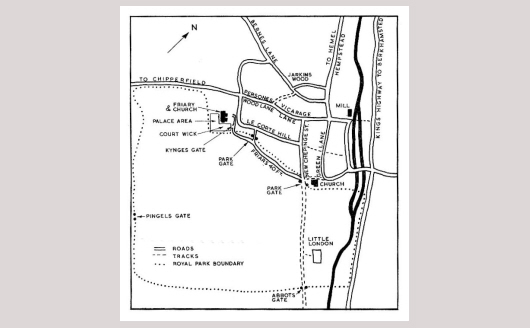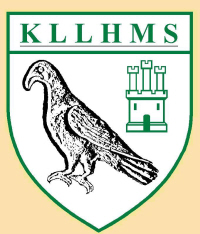History of the Royal Palace
In medieval times there was a real meaning in the inclusion of 'King's' in the name of the village. For 200 years the Kings and Queens of England and their families visited the village regularly and some of them spent important parts of their lives here.

The earliest known royal residence in Kings Langley was a hunting lodge in the time of Henry III (reigned 1216-1272). This was probably at Little London (between the present canal and A4251 road, towards Langleybury), built there for hunting in the royal forest— a deer park thick with oaks and beeches, part of a great forest stretching from London out to Berkhamsted.
The Manor of Chilterne Langley or Langley Chenduit came into Royal hands first when Queen Eleanor of Castile acquired the site in 1276. The original Manor is thought to have been near the Church, but in 1278 there is a mention of a "new- start". It is surmised that this was the date when the Palace at the top of the hill was started. The right angled turn of the road at the top of Langley Hill marks where the road ran straight into the Manor, through "the Corte Gate". The South boundary of the Rudolf Steiner School ground marks approximately the boundary between the Palace and Park, and rough foundations of a wall were found in 1963 showing that the Eastern edge of the Outer Court ran about 10 feet to the East of the Hall and Classrooms.
Between the years 1279 and 1281 a great deal of building work was done as well as a new garden being planted with vines. The Queen, who died in 1290, has been credited with the introduction of carpets and baths (les stues). The accounts of 1291-1292 show money being used to embellish the buildings. The hall was painted and decorated with 54 shields and a picture of 'four knights seeking a tournament'.
Edwards I, II and III
In 1291 a mason, Martin of Ray, was paid £66/13/4 for making a cellar. The next mention of which comes in 1308, during the reign of Edward II, when horses were kept in "La Cave" as the great cellar was called. (This poses a problem as there has been no archaeological evidence of the presence of horses nor of their ingress or egress.) In the same year accounts mention "coopering tuns of wine at La Cave".
In 1302 Edward I granted Langley to his son and heir Edward of Caernarvon, who had already spent much of his youth here and who was to keep the place in his own hands as his favourite residence until his death. After his mother died Edward II established a Dominican Friary at Kings Langley in 1308.
By early in the 14th century the Palace was described as having three courts. The great court contained the principal royal apartments which included the hall and chapel, prince's chamber and queen's chamber. The domestic buildings including bakery, larder, roasting house and saucery in addition to the Great Kitchen. There were also stables, barns and mills, a hunting lodge and Great and Little Parks and gardens. Langley was also a favourite residence of Edward III, who used it as his Seat of Government during the Black Death. His fourth surviving son Edmund de Langley was born here in 1341 and the occasion was marked by a tournament. He became the 1st. Duke of York. The three children of Edmund and his wife Isabel of Castile spent many of their years at Kings Langley. The daughter Constance was known as the White Rose of Langley. Edmund and his wife were first buried at the Friary next to their Palace home. Later their rich tomb was moved to the Church of All Saints in the centre of the village, where it still stands.
During Edward III's reign considerable work was done on the bath house with hot water for which cisterns and an oven in "a new kitchen for the stues" were installed. (A large area of hearths and a possible hot plate was discovered some distance east of the cellar). Also listed were a counting house, an organ and a camel! The 'Corte Gate' or main approach to the Palace stood at the top of Langley Hill. In 1368 the king installed a striking clock, made by John Belleyetere, in the Belfrey of the Friary Church.
Richard II
The accounts for the years 1384-1388, during Richard II's reign, show that a large amount of work was done when "the afore said stue broken by the said lord king" was repaired. Locks were also supplied "for a certain little gate between the Inner and Outer Courts and for the doors of the adjacent Church of the Friars Preachers to keep and exclude the said Friars from the Kings Household." Richard II (1377-1399), son of the Black Prince, was greatly attached to Langley as a boy. He held stately courts and issued proclamations from the Palace of Langley Regis. In 1392 and in 1396 he brought the court to celebrate Christmas.
One scene in Shakespeare's `Richard II' is set in the garden at Langley. During his reign the poet Geoffrey Chaucer was appointed Clerk of Works for the Manor of Chilternlangley. Richard was often at Langley and after the Peasants Revolt (1382) he came here from St. Albans where he had been obliged to agree to cruel punishments, but here, on his own manor, mercy prevailed. We know the names of the local rebels who burnt houses behind the Saracens Head. They all appear to have prospered later. When Richard II was deposed and died as a prisoner in Pontefract Castle — murdered according to Shakespeare on behalf of the usurper Henry IV (1399 1413) — his body was brought to the Friary at Langley for an ignominous burial. "The great ones were not there, neither was there any crowd of common people, nor was there anyone to ask them (the Bishops of Chester and St. Albans) to dinner after their task". The body was later removed to Westminster by Henry V in 1414.
Henry IV and Henry VIII
Richard's successor Henry IV granted Langley Manor to his Second wife Joan of Navarre. She continued to live there until her death in 1437 even though in 1431 the Palace was damaged by fire, "through the negligence and drowsiness of a minstrel and insufficient care of a lighted candle". Three of Henry VIII's wives were granted the Palace but none lived in it and the buildings fell into decay. The Manor was subsequently held by Cicely, Duchess of York and then was allowed to decay.
In 1487 Ralph Verney was granted the lordship of Langley and may have built some accommodation for himself on the site. We have records of "Verneys Lodgings" which must have been a fairly large and habitable house. In 1534, as shown by the order of Henry VIII, the Manor of Kings Langley was to be prepared as the residence of the infant Princess Elizabeth, but there is no record that anything was done.
A survey of the buildings of the Friary in 1552 mentioned "a little Mansion called Verneys Lodgings" and "three old and decayed buildings beyond repair. " These Lodgings are again mentioned in 1554 as a "fayre lodging" occupied by the Countess of Bedford, but in 1591 Verneys Lodging is the name of a three acre field and the "seite of the manor" is reported as "decayed".
Excavations
The information above is derived from historical documents and is largely from an article written by Denis Miles (from notes made by Mrs Mary Tisdall) for the Kings Langley Museum Society Newsletter No 4 in 1970. Three excavations carried out in 1962, 1970 and 1974-6. revealed exactly where the different parts of the Palace had been. `La Cave' or the large cellar was uncovered and also the foundations of 'Le Longrewe' or long house which is believed to have contained the principal apartments. Building works of the last hundred years have, however, sadly destroyed the chance of knowing how large the Palace was and how it was laid out. The site is now occupied by the Rudolf Steiner School.
A full report of the excavations of the Palace of Kings Langley conducted by David Neal in 1974 - 76 is held in our archives.




